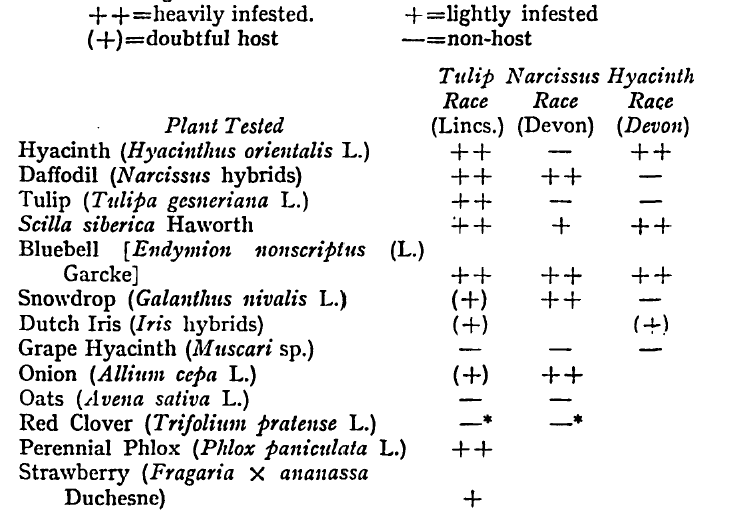Article contents
Observations on Races of Ditylenchus dipsaci Infesting Bulbs
Published online by Cambridge University Press: 18 November 2009
Extract
The results obtained in the tests described above are summarized in the following table :—

Matricaria matricarioides (Less.) Porter, self-sown in one of the inoculated pots, is an addition to the known weed hosts of narcissus races of D. dipsaci and a new host record for the species.
Seinhorst (1952) has emphasized the need for caution in interpreting the results of host tests with D. dipsaci. Exposure to heavy infestations will often result in invasion and local necrosis of the tissues of plants which are not true hosts of the race concerned. Seedlings may easily be killed outright in this way. The present tests lead to similar conclusions as shown, for example, by the results obtained with red clover and oat seedlings. Even deposition of eggs in the tissues cannot be taken as evidence that the eelworms have established themselves. It is considered, however, that a plant may be regarded as a true host when it is clear that the eelworms are breeding freely in the tissues, i.e. when eelworms in all stages of development are present with numerous eggs, and when infestation is able to persist during the normal life of the plant. With bulbous plants, the establishment of an infestation in the new bulbs after the leaves and flowers had died down was taken as evidence that the plant was a true host. The typical effects of D. dipsaci on the tissues of its hosts, e.g. hypertrophy of parenchyma tissues, enlargement and loosening of the cells and dry, mealy rotting, are also useful criteria, but some of these effects may be produced occasionally after invasion of non-hosts, as was found in a few of the inoculated clover seedlings.
- Type
- Research Papers
- Information
- Copyright
- Copyright © Cambridge University Press 1957
References
- 3
- Cited by


